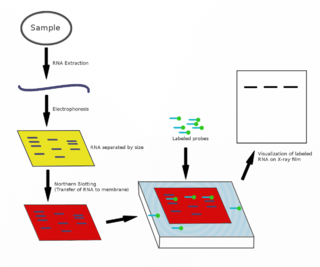
Small Cajal body specific RNA 24 is a small nucleolar RNA found in Cajal bodies and believed to be involved in the pseudouridylation of U6 spliceosomal RNA.
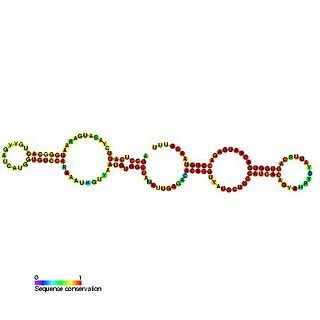
NORA1 is a member of the H/ACA class of small nucleolar RNA that guide the sites of modification of uridines to pseudouridines.

In molecular biology, SNORA2 is a non-coding RNA (ncRNA) which modifies other small nuclear RNAs (snRNAs). It is a member of the H/ACA class of small nucleolar RNA that guide the sites of modification of uridines to pseudouridines.
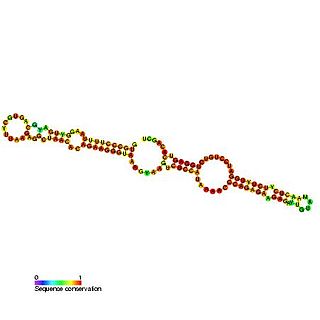
In molecular biology, SNORA26 is a member of the H/ACA class of small nucleolar RNA that guide the sites of modification of uridines to pseudouridines.
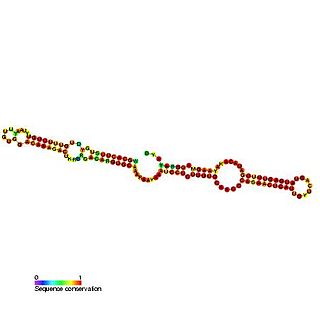
The small nucleolar RNA ACA40 belongs to the H/ACA family of snoRNAs and guides the pseudouridylation of 28S rRNA subunit at position U4565. snoRNA ACA40 was discovered using large-scale cloning by Kiss et al. (2004) from a HeLa cell extract immunoprecipitated with an anti-GAR1 antibody. It is predicted to guide the pseudouridylation of residues 28S rRNA U4546 and 18S rRNA 1174. The pseudouridylation of these residues was reported by Ofengand and Bakin (1997) and Maden (1990). ACA1, ACA8, ACA18, ACA25, ACA32 and ACA40 and the C/D box snoRNAs mgh28S-2409 and mgh28S-2411 share the same host gene (MGC5306).
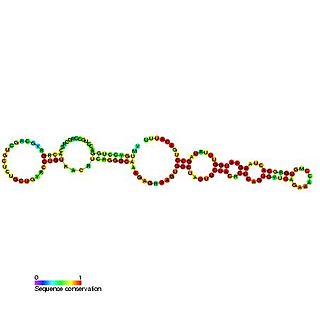
Small nucleolar RNA SNORA43 is a non-coding RNA (ncRNA) molecule which functions in the biogenesis (modification) of other small nuclear RNAs (snRNAs). This type of modifying RNA is located in the nucleolus of the eukaryotic cell which is a major site of snRNA biogenesis. It is known as a small nucleolar RNA (snoRNA) and also often referred to as a 'guide RNA'.

Small nucleolar RNA SNORA44 is a non-coding RNA (ncRNA) molecule which functions in the biogenesis (modification) of other small nuclear RNAs (snRNAs). This type of modifying RNA is located in the nucleolus of the eukaryotic cell which is a major site of snRNA biogenesis. It is known as a small nucleolar RNA (snoRNA) and also often referred to as a 'guide RNA'.
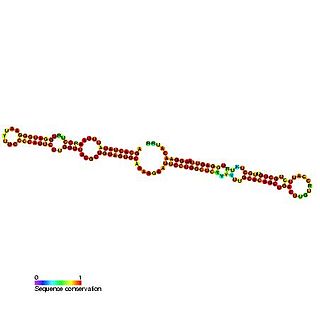
Small nucleolar RNA SNORA46 is a non-coding RNA (ncRNA) molecule which functions in the biogenesis (modification) of other small nuclear RNAs (snRNAs). This type of modifying RNA is located in the nucleolus of the eukaryotic cell which is a major site of snRNA biogenesis. It is known as a small nucleolar RNA (snoRNA) and also often referred to as a 'guide RNA'. ACA46 was originally cloned from HeLa cells and belongs to the H/ACA box class of snoRNAs as it has the predicted hairpin-hinge-hairpin-tail structure, has the conserved H/ACA-box motifs and is found associated with GAR1 protein. snoRNA ACA46 is predicted to guide the pseudouridylation of U649 of 18S ribosomal RNA (rRNA). Pseudouridylation is the isomerisation of the nucleoside uridine to the different isomeric form pseudouridine.
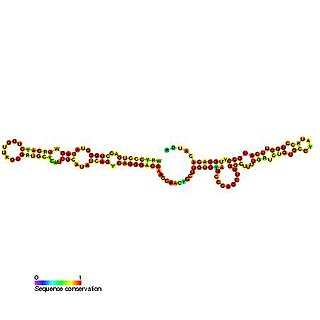
Small nucleolar RNA SNORA48 is a pseudouridylation guide H/ACA box snoRNA. This snoRNA was cloned in 2004 from a HeLa cell extract immunoprecipitated with an anti-GAR1 antibody. It is predicted to guide the pseudouridylation of residue U3797 of 28S rRNA.

Small nucleolar RNA SNORA50 is a non-coding RNA (ncRNA) molecule which functions in the biogenesis (modification) of other small nuclear RNAs (snRNAs). This type of modifying RNA is located in the nucleolus of the eukaryotic cell which is a major site of snRNA biogenesis. It is known as a small nucleolar RNA (snoRNA) and also often referred to as a 'guide RNA'. ACA50 was originally cloned from HeLa cells and belongs to the H/ACA box class of snoRNAs as it has the predicted hairpin-hinge-hairpin-tail structure, has the conserved H/ACA-box motifs and is found associated with GAR1 protein. snoRNA ACA50 is predicted to guide the pseudouridylation of U34 and U105 of 18S ribosomal RNA (rRNA). Pseudouridylation is the to the different isomeric form pseudouridine.
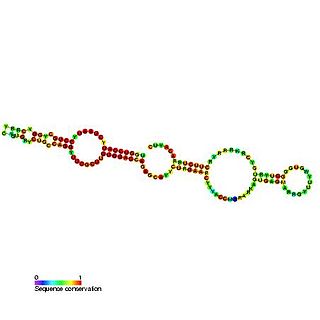
Small nucleolar RNA SNORA52 is a non-coding RNA (ncRNA) molecule which functions in the biogenesis (modification) of other small nuclear RNAs (snRNAs). This type of modifying RNA is located in the nucleolus of the eukaryotic cell which is a major site of snRNA biogenesis. It is known as a small nucleolar RNA (snoRNA) and also often referred to as a 'guide RNA'. ACA52 was originally cloned from HeLa cells and belongs to the H/ACA box class of snoRNAs as it has the predicted hairpin-hinge-hairpin-tail structure, has the conserved H/ACA-box motifs and is found associated with GAR1 protein. snoRNA ACA52 is predicted to guide the pseudouridylation of U3823 of 28S ribosomal RNA (rRNA). Pseudouridylation is the to the different isomeric form pseudouridine.

The snoRNA ACA53 belongs to the H/ACA family of pseudouridylation guide snoRNAs. This H/ACA box RNA was cloned by Kiss et al. (2004) from a HeLa cell extract immunoprecipitated with an anti-GAR1 antibody. It has no identified target RNA. RNA residues targeted for pseudouridylation by this molecule have not been identified.
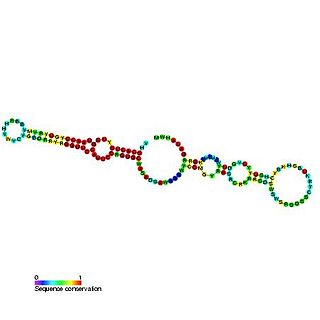
Small nucleolar RNA SNORA54 is a non-coding RNA (ncRNA) molecule which functions in the biogenesis (modification) of other small nuclear RNAs (snRNAs). This type of modifying RNA is located in the nucleolus of the eukaryotic cell which is a major site of snRNA biogenesis. It is known as a small nucleolar RNA (snoRNA) and also often referred to as a 'guide RNA'. ACA54 was originally cloned from HeLa cells and belongs to the H/ACA box class of snoRNAs as it has the predicted hairpin-hinge-hairpin-tail structure, has the conserved H/ACA-box motifs and is found associated with GAR1 protein. snoRNA ACA54 is predicted to guide the pseudouridylation of U3801 of 28S ribosomal RNA (rRNA). Pseudouridylation is the isomerisation to the different isomeric form pseudouridine.

Small nucleolar RNA SNORA55 is a non-coding RNA (ncRNA) molecule which functions in the biogenesis (modification) of other small nuclear RNAs (snRNAs). This type of modifying RNA is located in the nucleolus of the eukaryotic cell which is a major site of snRNA biogenesis. It is known as a small nucleolar RNA (snoRNA) and also often referred to as a 'guide RNA'. ACA55 was originally cloned from HeLa cells and belongs to the H/ACA box class of snoRNAs as it has the predicted hairpin-hinge-hairpin-tail structure, has the conserved H/ACA-box motifs and is found associated with GAR1 protein. snoRNA ACA55 is predicted to guide the pseudouridylation of U36 of 18S ribosomal RNA (rRNA). Pseudouridylation is the to the different isomeric form pseudouridine.
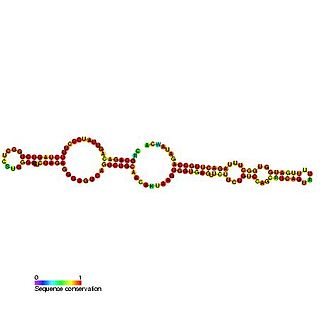
Small nucleolar RNA SNORA56 is a non-coding RNA (ncRNA) molecule which functions in the biogenesis (modification) of other small nuclear RNAs (snRNAs). This type of modifying RNA is located in the nucleolus of the eukaryotic cell which is a major site of snRNA biogenesis. It is known as a small nucleolar RNA (snoRNA) and also often referred to as a 'guide RNA'. ACA56 was originally cloned from HeLa cells and belongs to the H/ACA box class of snoRNAs as it has the predicted hairpin-hinge-hairpin-tail structure, has the conserved H/ACA-box motifs and is found associated with GAR1 protein. snoRNA ACA56 is predicted to guide the pseudouridylation of U1664 of 28S ribosomal RNA (rRNA). Pseudouridylation is the to the different isomeric form pseudouridine.
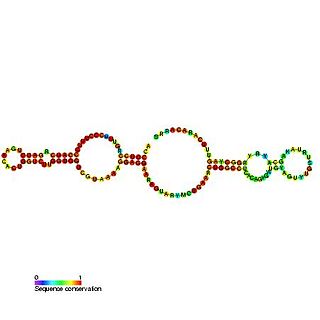
Small nucleolar RNA SNORA61 is a non-coding RNA (ncRNA) molecule which functions in the biogenesis (modification) of other small nuclear RNAs (snRNAs). This type of modifying RNA is located in the nucleolus of the eukaryotic cell which is a major site of snRNA biogenesis. It is known as a small nucleolar RNA (snoRNA) and also often referred to as a 'guide RNA'. ACA61 was originally cloned from HeLa cells and belongs to the H/ACA box class of snoRNAs as it has the predicted hairpin-hinge-hairpin-tail structure, has the conserved H/ACA-box motifs and is found associated with GAR1 protein. snoRNA ACA61 is predicted to guide the pseudouridylation of U2495 of 28S ribosomal RNA (rRNA). Pseudouridylation is the to the different isomeric form pseudouridine.

In molecular biology, small nucleolar RNA SNORA10 and small nuclear RNA SNORA64 are homologous members of the H/ACA class of small nucleolar RNA (snoRNA). This family of ncRNAs involved in the maturation of ribosomal RNA. snoRNA in this family act as guides in the modification of uridines to pseudouridines. This family includes the human snoRNAs U64 and ACA10 and mouse MBI-29.

Small nucleolar RNA SNORA11 is a non-coding RNA (ncRNA) molecule which functions in the biogenesis (modification) of other small nuclear RNAs (snRNAs). This type of modifying RNA is located in the nucleolus of the eukaryotic cell which is a major site of snRNA biogenesis. It is known as a small nucleolar RNA (snoRNA).

Small nucleolar RNA SNORA77 is a non-coding RNA (ncRNA) molecule which functions in the biogenesis (modification) of other small nuclear RNAs (snRNAs). This type of modifying RNA is located in the nucleolus of the eukaryotic cell which is a major site of snRNA biogenesis. It is known as a small nucleolar RNA (snoRNA).
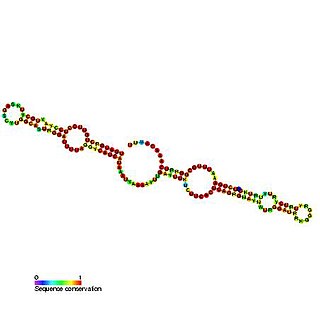
Small nucleolar RNA SNORA79 is a non-coding RNA (ncRNA) molecule which functions in the biogenesis (modification) of other small nuclear RNAs (snRNAs). This type of modifying RNA is located in the nucleolus of the eukaryotic cell which is a major site of snRNA biogenesis. It is known as a small nucleolar RNA (snoRNA).



